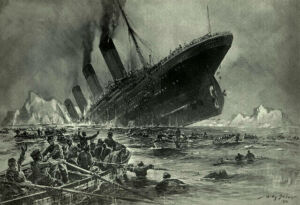Business & Education
How Carla’s ‘nightie to remember’ inspired the ‘King of the World’
This article is more than 10 years old.
James Cameron, the creator of the 1997 Oscar winner ‘Titanic’, partly based Kate Winslet’s role on a young Danish survivor of the 1912 disaster

Willy Stöwer painted this long before it was established that the vessel broke in half before finally sinking, just like Carla remembered (photo: Magazine Die Gartenlaube)
When Carla Jensen set sail from Fyn in 1912 for a new life in the USA, she couldn’t have imagined the fate that lay before her. Not only would she survive the 20th century’s most famous maritime disaster, but 17 years after her death in 1980, her story would become one of the inspirations for the most famous film in movie history.
James Cameron, the director of the 1997 film ‘Titanic’, came across a photo of Jensen displaying the nightgown she wore onboard, and this led to his creation of the character Rose (portrayed by Kate Winslet), and most notably that character’s appearance in the film as an elderly woman who in the film’s closing moments throws a necklace into the deep Atlantic – dressed, you guessed it, in only a nightie.
American dream becomes Atlantic nightmare
Carla Christine Nielsine Andersen-Jensen was one of the 231 Nordic passengers (123 Swedes, 63 Finns, 31 Norwegians and 14 Danes) on board the Titanic on that fateful voyage a century ago.
The 19-year-old housemaid from Fyn wanted to chase the American dream – just like her uncle, Niels Peder Jensen, a carpenter who had already settled in Portland, Oregon.
She obtained permission from her parents, bought a third class tickets for seven pounds, seven shillings and a penny, and embarked on the adventure of a lifetime. Sadly for many of her co-passengers, their lives were about to come to an abrupt end.
Her Jack was called Hans
One of them was Hans Peder Jensen, her fiancé. Together they intended to acquire their own farm once they arrived in ‘the land of the free’. However, for the journey they had to sleep in separate quarters at opposite ends of the boat. Carla’s cabin was in the stern, while Hans, along with Carla’s brother and uncle, were located in the bow.
At the time of the collision with the iceberg, Carla was asleep, and the first she knew about the unsinkable ship’s unthinkable dilemma was when she was woken up by her uncle. “I heard a knock and my uncle said: ‘You better put a coat on and come up on the deck,’ so I put a coat on over my nightgown[and clothes],” she later wrote in a letter.
She was the only one of the group allowed into a lifeboat. Her uncle joked with her that she would “come to New York a year ahead of us.”
Sitting like stone figures
“When the lifeboat I got into rowed away from the Titanic, the orchestra was still playing,” she wrote. “One said later it was the psalm ‘Nearer My God to Thee’. That is possible. It was not the time to listen, and I did not know the psalm since it was in English.”
And then the finale happened before anyone expected it. “With fright we heard an incredible crash, and it was as if a scream from 1,000 voices came from the lit giant ship, when it broke in two and both parts rose into the sky and sank. We sat like stone figures and saw it all happen. What was even worse than the screams was the deadly silence that came after … it was frightful.”
Unlike Rose, she did not settle
Carla was taken to a hospital in New York. From the hospital she sent a telegram home to her family telling them she had survived, but that the rest had not. Her father told her to come home immediately. The boat’s owner, White Star Line, gave her a second-class ticket to Liverpool and she arrived back in Fyn on 13 May, after which she never travelled out of Denmark again.
Carla married a farmer from Oremark in 1915, where they raised three children. For the rest of her life she observed a tradition on the anniversary of the Titanic’s sinking. She would put on the nightgown she had worn and stay up, all night, to see in the morning of April 15, just as she had done in 1912. Shortly before her death in 1980, her story was picked up by a Danish newspaper, which ran a picture of her holding the nightgown. She was, at her own request, buried in it.
A missing necklace too
It has been suggested that Cameron saw this picture of Carla and that her nightgown was an inspiration for his creation of Rose – particularly the scene at the end of the film in which Rose throws a valuable necklace, ‘The Heart of the Ocean’, into the sea.
If this is true, then Cameron – and no doubt Carla had she still been alive – would have seen the irony in the theft of a valuable necklace from Tivoli’s special Titanic exhibition in September 2011.
Unlike ‘The Heart of the Ocean’, it actually was found in the wreck of the boat (in the film, Rose has it all along) in the pocket of a deceased butler, who might or might not have stolen it (just like Rose) from an American passenger.










































